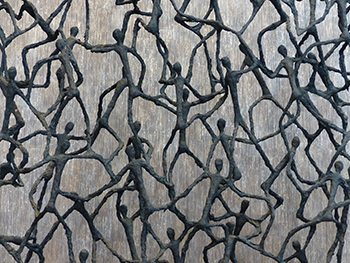"design culture" entries

Simon King on design at IDEO
The O’Reilly Design Podcast: Team dynamics and culture at IDEO, design education, and design’s next big challenge.
Subscribe to the O’Reilly Design Podcast, our podcast exploring how experience design—and experience designers—are shaping business, the Internet of Things, and other domains. Find us on Stitcher, TuneIn, iTunes, SoundCloud, RSS.
In this week’s Design Podcast episode, I sit down with Simon King, director of Carnegie Mellon University’s Design Center. King is the author of Understanding Industrial Design. We talk about team dynamics and culture at IDEO, extending design education to non-designers, and design’s next big challenge.
Here are a few highlights from our conversation:
CMU’s Design Center and the designer shortage
The idea is behind the Design Center is to bring design to more students across the whole campus and to create new kinds of research opportunities to work with organizations from outside of the university as well. There’s really two levels to think about the designer shortage, and one is what I’m trying to do with the Design Center: increasing the overlap with design that many people might have, where there’s this idea that you’re able to hire someone who’s design savvy, or design literate, or can bring some of the tools of design to their core discipline. That helps, but the bottleneck of ‘there just aren’t enough really skilled designers coming out of master’s programs and that are true experts’—I don’t have a good solution to that. I look at it and I think, ‘design is something you have to learn by doing. You have to build up this set of experiences over time, and it just takes time.’ There’s no silver bullet in terms of meeting the increasing demand.
Combining it with formal education might be more about a bigger mindset shift and not as much about specific skill building. Another approach is something we’re seeing at CMU, where there’s now a variety of programs. At the master’s level in the School of Design, there’s now options for students that are one year in length, or two years in length, or if they didn’t come in with a design background previously, potentially up to three years in length. It used to be there was just a two-year master’s program. I think that universities are recognizing the need for flexibility there, so that, depending on people’s goals or the time commitment that they’re willing to put in, there’s options for them.

IBM is banking on design’s ROI
Phil Gilbert on IBM’s deep design roots, change management, and hiring for culture fit.
Companies of all sizes are recognizing that by taking a design-first approach to product development, they can improve profit. I recently sat down with Phil Gilbert, GM of design at IBM, to discuss how he is helping to lead the transformation to a design-first company within IBM. Adopting design as a key corporate asset may seem like a no-brainer, but for a company of more than 350,000 employees, it’s a massive undertaking. IBM hasn’t been quiet about its plans to hire 1,000 designers over the course of five years and embed design in product teams throughout the organization.
IBM’s long history of design
What I was surprised to find when reading about IBM’s latest design plans, is that the giant tech company has design roots dating back to the 1950s. Gilbert shares in more detail:
We started our first design program — and we were one of the first to really apply design holistically at scale — in 1956. In the 1950s and the 1960s and into the early 1970s, we had a constellation of designers around IBM that, quite frankly, has never been equaled.
Elliott Noyes was our first head of design. Thomas Watson Jr. hired him in 1956. He assembled people like Eero Saarinen, Charles and Ray Eames, and Paul Rand. He assembled this team of people, and, essentially, I think the reason it happened then is because humanity was addressing a fundamentally different relationship between ourselves and technology. There was a lot of turmoil and angst as a result. We used design at that time to communicate and engage in a conversation with humanity about that relationship and about our role with technology. We viewed it as a very holistic statement — we communicated it through our products, our communications, our buildings, and we did it through our exhibits at places like the World’s Fair.
Since then, I don’t think there has been as fundamental a change in the relationship between human beings and technology. The move from mainframe to mini-computer, the move from mini-computer to personal computer, the move to client-server computing — all of these things were actually fairly incremental. But I think in 2007, with the release of the iPhone and with the ubiquitous access via mobile devices, I actually think that we’re, again, in a time of real turmoil and change around this relationship of where does technology sit with human beings.
This is a real change, and I think that human-centered design and design thinking as a method to achieve human-centered design is why it’s become so important. Because our relationship with technology is, it may not be as frightening as it was in the 50s and 60s, but it certainly is fundamental. I don’t think we quite yet understand it. I think design is the primary lever that we have to understand that relationship and then to communicate that relationship.

